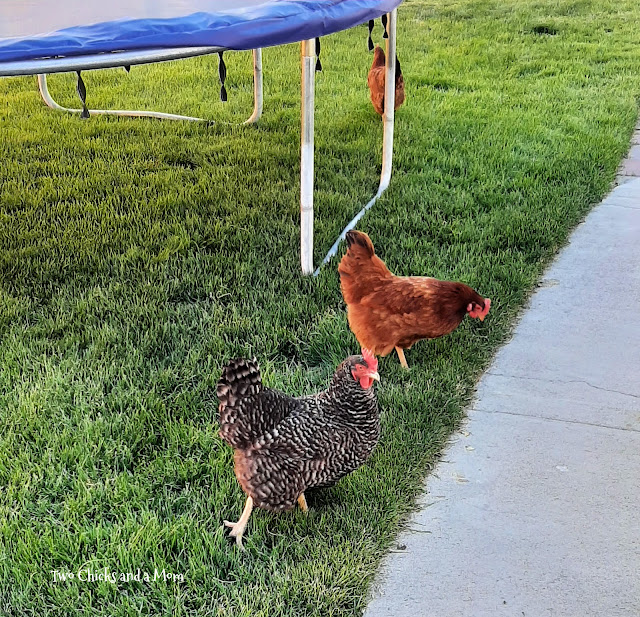I am not a poultry expert so please consult with others who might be if you decide to raise chickens. This is a condensed version of our first year as backyard chicken owners.
*Photo above: Eva, Hallie, Piety, and Annie Lou (all named after family grandmas or great-grandmas)
Getting back to basics is more than a trendy thing to do nowadays. For many, it is a necessity related to rising prices, food shortages, job loss, questionable ingredients in processed foods, and more factors.
For some, it can bring a feeling of independence and satisfaction. For others, it could be a hobby or bring a sense of relaxation to the day. Whatever your reason is, let's start with some "basics" that my family recently returned to--raising backyard chickens.
As a child, my maternal grandparents lived on a small farm in northern Florida and grew vegetables (I recall the okra vividly as it would poke me when I helped my grandpa pick it) and had chickens. We, too, while living in Jacksonville had several Silkie hens and roosters. I always enjoyed watching Henry, Herman, Henrietta, Sally, and Susie wander around our yard. Silkies, by nature, are gentle chickens and easily put up with my toting then around the yard. On a side note, our next door neighbor raised chickens as a living and i would often help him in my pre-school days in gathering eggs and probably just getting in the way. I am sure he sold the eggs, the chickens, and their meat but for my post today, I will just speak to raising chickens for eggs and pleasure. My girls are my girls and they aren't going in my soup pot!
We purchased 4 chicks in Spring of 2021, two Black Barred Rock and two Red Sex Link. All four were hens (often can't tell till later) which was good as we didn't want babies and in the city limits, you can't have roosters. Make sure you check your city ordinances for how many hens you can have, if you can or can't have roosters, building specifications for coops or feet away from other neighbors, etc. Better to be informed than surprised!
Make sure you confer with someone who has chickens already or do online research so you are prepared before obtaining your little flock. We simply used a storage bin, an overhead warming light, straw, and feeder/waterer to care for them as days-old chicks. Until they are fully-feathered, you want to keep the little ones warm and not allow them outdoors at cold temps. We got out girls in early April and after a few weeks we let the spend some time in the sunshine during the day but placed a wire dog kennel over them so they could peck at the grass and bugs but be safe. Fully feathered chickens depend on the breed but no more downy heads (fluffy butts okay lol) and can happen from 4 to 8 weeks or more, depending on the breed. Take into account the climate and current weather for your area, too.
Don't forget the feed! Your local feed store can help you choose the correct protein level, etc. for your chicks to start on, medicated or non-medicated, etc. Some may recommend powdered electrolytes to add to their water, especially if they get "pasty butt". It's a thing and can be concerning if not treated.
While those girls were growing and feathering, we purchased a chicken coop online from Tractor Supply. My husband assembled it and added some primer to it but I never got around to painting it a trendy color lol. Look for a coop that has plenty of room for each chicken--you don't want them on top of each other and since they usually spend the evenings in there, be considerate. A minimum of 2 to 3 sq. ft. per chicken in the coop is advised. Some breeds are just bulkier chickens and some are smaller (bantam) size and may not need as much room. I would advise that they can stretch their wings and move from one area of the coop to another without stepping on each other but no guarantees there.
There are various methods for roosting and sleeping for your flock and keeping them warm and dry. Our coop has a small space between the side wall and the roof so there is ventilation for the chickens, which is important. Just big enough for fresh air to circulate.
We add straw to our coop floor so the chickens have that for warmth and also a soft place to lay their eggs. It also is used for making a mess lol. Again, there are various methods and materials that can be used for comfort and warmth--I will add links to this post so you can check into those.
Fluffy butts!
My husband added in a steel dog run for the girls to use during the day when they are out of the coop. Ignore the tarp--that goes up when it rains. The kennel is 6' tall by 10" long by 4' wide so they 4 ladies have room to dust bathe, forage, roost, and whatever else they do. Look around online and speak to others about what they do for protection and space.
Some prefer to let their chickens free-range during the day or all the time and just have a very basic coop setup. I have been working from home so I have the luxury of letting the girls out into our backyard several times a day to free-range for worms, bugs, and weeds. I feel better since I am home and have a listening ear (unless I am with a patient) but I will say that I am a worrier. Most people may not worry about their chickens as much as some of us do.
The ladies just got their tails in this photo below!
We have a nice backyard and I will tell you this--chickens will eat or destroy anything. I found that out last winter when I discovered my succulent patch, that had been thriving for over 20 years, was no more. Fair warning to all! Our coop and run is in a side yard and since I am in the process of planting new succulents, I still let them free-range in the backyard, till I have a plan for adding my succulents. After that, it's the side yard strictly for them.
We have also planted a chicken garden, just for them. While not in this photo, the upper righthand corner in this pic is where we have planted a little patch of greens and herbs that our girls enjoying feasting on.
This is the color of egg that all four of our hens lay, pretty much each day. Many breeds will slow down in the cooler months and you might not get any eggs somedays. This is a photo of the very first egg that one of our ladies laid and she sure let us know it! So loud--we had to run outside and see what was happening. The shade varies a bit, sometimes darker, sometimes a bit more light.
Here are some websites that have been helpful to me on my flock journey:
If you decide to add a few chickens into your lifestyle, I suggest adding at least two so they have a friend. You can always add a couple of more as you go!
FEATURED AT
THANKS FOR STOPPING BY!


.jpg)
.jpg)
.jpg)
.jpg)
.jpg)
.jpg)
.jpg)
.jpg)
.jpg)
.jpg)





%20(1).png)











.jpg)







Sp Kingstown ne w project is a good example of a well-executed modern facility with high quality. Thus, it's a wonderful new reservation since you good right time can obtain the best amenities possible, best like new making it possible
ReplyDeletehttps://www.apsense.com/article/sp-kingstown-premium-residential-hadapsar-annexe-area-of-pune.html